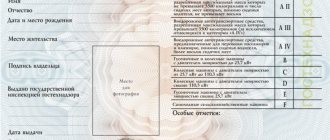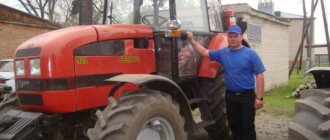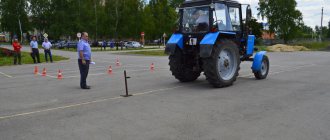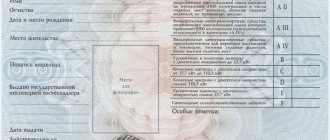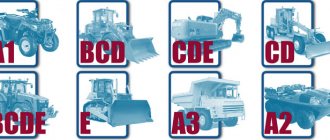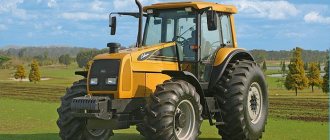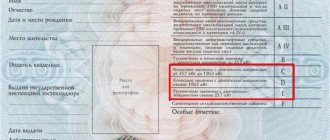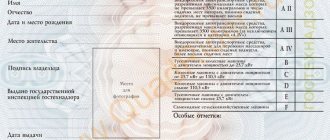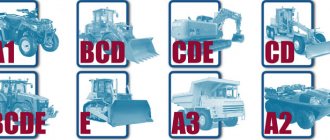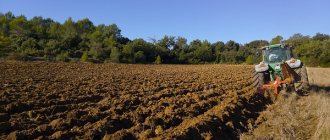Good afternoon, dear reader.
Today I bring to your attention the first article in the series “Changes in the rules for obtaining tractor driver’s licenses from November 13, 2011.” As you may have already guessed, this article will discuss the changes that will soon be made to the next regulatory legal document, which also applies to car drivers.
In this series we will talk about the changes that have been made to the rules for admission to driving self-propelled vehicles and the issuance of tractor operator (tractor driver) licenses. The innovations were published in the Decree of the Government of the Russian Federation “On Amendments to the Rules for Admission to Operating Self-Propelled Machines and Issuing Tractor Driver (Tractor Driver) Licenses,” which comes into force on November 13, 2011.
Today we will review only a small part of the changes. First of all, we will talk about tractor driver’s licenses and the new categories that will be present in this certificate, starting from November 13.
Types of special equipment
A license to drive a tractor is required for everyone who operates the following types of self-propelled machines:
- tractor;
- trackless vehicles;
- road cars;
- excavators;
- forklifts;
- snowmobiles.
They can only be managed by obtaining a certificate or temporary document, which is issued after completing an internship at a business enterprise.
Where do they train to become drivers of self-propelled and special vehicles?
To qualify for an excavator, you must take courses at a special training center. Students are allowed into the park of special equipment within the category of rights, as well as into a site equipped for obtaining practical skills and driving a car.
For information: the training period depends on actual driving experience, but usually it is about 45 days. Knowledge and practical skills are checked by a Gostekhnadzor specialist; this organization produces and issues licenses.
How to choose a training center for training and obtaining a license? On average, such establishments should have:
- state permit and license to conduct training;
- a place for practical training;
- a fleet for special equipment that meets the training requirements of each category.
Upon confirmation of the order and approval of the invoice amount, a message will be received electronically within 24 hours confirming the success of the transaction.
Students are allowed to enter the special equipment park within the category of acquired rights, as well as to a site equipped to obtain practical driving skills.
Requests to candidates
Not everyone can operate a mini tractor, loader, excavator or other self-propelled equipment. There are certain requirements for candidates. First of all, by the time they passed the exam they had to reach the age of majority and have no health contraindications when driving vehicles. To operate, excavator operators must have a good knowledge of special equipment, namely:
- understand the device;
- be able to perform repair work;
- monitor technical condition;
- work safely;
- operate the vehicle safely;
- have practical skills in operating equipment.
During the training process, they study drawings and diagrams that must be understandable to the machine operator. In order to perform your work efficiently and safely, you need to know the characteristics of various soils and bulk materials. Persons who have passed a medical examination are allowed to work.
Tractor classification
This technique includes self-propelled vehicles, the main functional load of which is considered to be:
- performing most types of agricultural work;
- road construction work;
- transportation in enterprises;
- excavation work.
Their distinctive feature is low speed compared to conventional machines while maintaining increased traction. There is also a difference in the design. Main components of self-propelled vehicles:
- body;
- engine;
- transmission;
- chassis;
- control system.
Based on the type of travel, a distinction is made between tracked and wheeled vehicles. The former work on a dirt road, the latter perform tasks on an asphalt road, therefore they are more in demand in production and in road construction. The traction force of wheeled vehicles on loose soil drops noticeably, so to increase functionality they are made with all-wheel drive. On the one hand, this is a plus, but on the other hand, when performing agricultural work, wheeled equipment greatly compacts the soil.
Conditions for registering homemade mini tractors
Handicraft self-propelled vehicles also need to be registered with the Gostekhnadzor authorities. To carry out the procedure, an adult owner should contact the appropriate authority with a package of documents
- application for registration of a converted and self-assembled mini tractor;
- passport with registration at the place of residence (permanent or temporary registration mark);
- originals and/or copies of sales receipts for purchased parts and technical components used in the assembly/modification of the tractor.
Based on these documents, service specialists will set a date for examination and technical inspection of the self-propelled vehicle: to what extent it complies with state technical and environmental standards. A compliance certificate is drawn up, which in turn is the basis for registering/rejecting a homemade tractor. If, during the examination, full compliance with the standards and suitability of the home-made mini tractor for operation is proven, then registration is carried out, and the owner is issued a technical passport and vehicle number. For a registered home-made unit, the owner can, by passing exams at the State Traffic Safety Inspectorate, obtain a license of the appropriate category.
What categories of rights are there for a tractor?
Opening a group of rights to drive a tractor depends on the category to which the self-propelled equipment belongs. Today there are 6 groups of rights with 4 subgroups.
Group A
It includes motor vehicles with a motor capable of reaching speeds of up to 50 km/h. They are subject to restrictions on movement on public roads. There are 4 subcategories of vehicles:
- A1 – self-propelled motorized SUVs with a speed of up to 50 km/h. These include swamp vehicles, all-terrain vehicles, motor sleighs;
- A2 – motor transport self-propelled off-road vehicles with up to 9 passenger seats, weighing up to 3.5 tons. The subclass includes all-terrain vehicles and mining dump trucks;
- A3 – vehicles with 9 seats weighing more than 3.5 tons, not intended for movement on public highways. These are dump trucks and special purpose all-terrain vehicles;
- A4 – equipment for up to 8 passenger seats. Subgroup 4 includes road trains, platform and rotation buses.
Group B
The initial category, with which you can drive a tractor with a motor of no more than 25.7 kW or 35 hp. It includes tracked and wheeled vehicles. These are mini-excavators, mini-tractors and municipal cleaning equipment.
A driver who has received a category B license can drive a tractor with trailer loads of various sizes, as well as participate in loading and unloading equipment.
Group C
It is considered the most common. It includes self-propelled wheeled vehicles with power from 25.7 to 110.3 kW or from 35 to 150 hp. These are the main models of tractors and backhoe loaders with trailed equipment of different weights and sizes.
Group D
Category D includes tractors only on wheels with an engine of more than 110 kW or 150 hp or more. This includes pneumatic cranes, powerful front loaders, and MTZ wheeled models. Another type is machines that move containers in ports.
Group E
Category E tractors include self-propelled tracked vehicles with an internal combustion engine with a power of 25.7 kW or 35 hp. This group includes basic tractors, excavators, bulldozers and all-terrain vehicles.
Group F
Category F includes self-propelled agricultural machinery, or grain and forage harvesters with increased power and carrying capacity.
FAQ All-terrain vehicles. Answers to frequently asked questions about swamp vehicles.
To register the UTM, the candidate should provide the following documents to the regional Gostekhnadzor inspection:
- Russian passport;
- photo 3x4 – 2 pcs.;
- sample application;
- UTM (if issued previously);
- receipt of paid state duty;
- certificate of training completed at a driving school;
- driver's license (if available, without it you will need to pass the traffic rules);
- medical report (with o);
Having successfully passed the examination test, the driver receives a category A1 tractor driver license for 10 years. The “Special Notes” section in the received UTM is filled in with information of a restrictive or permissive nature. Typically, data indicating driving with glasses, blood type, overall driver experience, as well as health restrictions that prohibit the opening of other categories are entered in this column.
When purchasing a snowmobile, the potential owner must be aware that he is buying self-propelled equipment that requires special attention and responsibility. Motorized vehicles with an engine capacity of more than 50 cm3 must strictly be registered with the regional department of Gostekhnadzor. At the same time, if the vehicle reaches a speed of over 20 km/h, then the owner should take out a compulsory motor liability insurance policy in this situation.
Quite often, people who bought a snowmobile for infrequent trips to the village or to a sparsely populated place do not consider it necessary to spend time and money on registering it.
Snowmobiles with an engine displacement of more than 50 cm3, or an electric motor power of more than 4 kW, must be registered with the state no later than 10 days after their purchase.
To do this, the owner of the vehicle or an authorized person acting on his behalf must appear at the territorial body of Gostekhnadzor with the following papers:
- vehicle owner's passport;
- PSM (self-propelled vehicle passport);
- receipt of paid state duty;
- application for vehicle registration according to the sample;
- certificate of quality conformity for equipment;
- OSAGO policy (for models reaching speeds of more than 20 km/h);
- agreement for the purchase of equipment (with the date of signing no later than 10 days before the application);
- registration certificate (if the vehicle has already been registered with the state).
Driving self-propelled vehicles requires the driver to have special knowledge and skills that come during training. You can take a training course at educational institutions licensed to conduct such activities. Students are trained according to special vocational education programs or additional vocational education.
Since November 2015, independent education of citizens to register for the UTM category outside of a driving school is unacceptable.
The training course takes 3-4 weeks at the training center. This time is enough for students to listen to lectures on a theoretical course, including the basics of traffic rules and rules for operating a snowmobile. The student must know the nuances of the design of a self-propelled machine and the list of its malfunctions. Any breakdown or accident that occurred far from a populated area or in the absence of communication should not become a serious problem for him in the future.
Having passed internal testing at an educational institution, the candidate is obliged to confirm his knowledge and pass a full-fledged exam at Gostekhnadzor to receive a technical technical supervision with subcategory A1. The examination test contains theoretical and practical parts.
The cost of training to operate a snowmobile depends on the special training of the individual candidate.
Training centers provide various options for the educational process and its payment:
- Full course - theory and practice. The price range for such a course is wide. You can find a comprehensive program for 7,000 - 10,000 rubles, which includes a full theoretical course and 10 practical lessons with an instructor. There are training centers that offer only theory for this amount, but practice driving a vehicle is estimated at 700 rubles per lesson.
- Theoretical course. A candidate who is excellent at operating equipment can do without practical training, but is required to study the technical structure of self-propelled vehicles and traffic regulations. The price for a training course is determined depending on the region and varies from 5,000 to 7,000 rubles. The duration of the course is on average 2 – 4 weeks.
- Distance learning. This package applies to experienced drivers who have a driving license. The driving school frees such students from constantly attending lessons. They prepare for the exam using online tests. The cost of the course also has different prices and depends on the availability of rights of a particular category.
On average, distance learning can cost 5,000 – 9,000 rubles. This type of training should not be confused with self-study of the basics of operating self-propelled vehicles, which has been banned in Russia since 2015.
Before the procedure for obtaining the UTM, the candidate should pay a state fee to the budget of the regional department of Gostekhnadzor. For obtaining a license on paper, the state duty will be 500 rubles, on plastic – 2,000 rubles.
The candidate can pay the mandatory fee in any convenient way: the State Services portal, Sberbank Online, a terminal of any bank or a Russian Post office. Payment details are available on the official website of Gostekhnadzor or at the territorial office of the department where the exam will be held.
Working categories
In addition to opening a certain category of license, tractor drivers regularly undergo certification and advanced training. After passing exams and meeting standards, the following categories are assigned:
- 2nd category. Gives the right to operate equipment under the supervision of an experienced tractor driver.
- 3rd category. Independent control, carrying out load-handling work using special devices, unloading.
- 4th category. Operation of machines with a power of up to 100 hp, carrying out unloading and loading operations, warehousing and moving goods over a distance.
- 5th category. Self-propelled machines with an engine greater than 100 hp, such as crawler excavators and bulldozers.
- 6th category. Control of large self-propelled equipment, tractors, bulldozers, excavators with power above 200 hp.
Regardless of the category being opened, rights to a tractor are obtained only after completing special training in an organization licensed by Gostekhnadzor. Exams are taken at the departmental body.
Differences between a temporary tractor driver license and a temporary permit
The differences between a temporary tractor driver license and a temporary permit are given in the text of the updated paragraph 9 and subparagraph 91:
9. The basis for admission to driving self-propelled machines for persons sent by educational institutions to undergo practical training for a period of up to 2 months is the corresponding certificate of a tractor driver (tractor driver) or a temporary permit for the right to drive self-propelled machines (hereinafter referred to as a temporary permit).
In the event of inspections when presenting documents that cast doubt on their authenticity, if there are grounds to believe that the person is deprived of the right to drive self-propelled machines or other vehicles, and in other cases, a temporary permit may be issued for the right to drive self-propelled vehicles of the corresponding category for a period of up to 2 months.
A temporary permit is issued on the basis of an extract from the examination sheet certified by the educational institution. The temporary permit is replaced with a corresponding tractor driver (tractor driver) certificate upon presentation of a document confirming completion of training without passing exams.
9. The basis for admission to driving self-propelled vehicles for persons sent by educational institutions to undergo practical training for a period of up to 2 months is a temporary certificate issued by the state technical supervision authorities. A temporary certificate is issued at the State Technical Supervision Inspectorate after passing, in accordance with the requirements of subparagraphs “a” and “b” of paragraph 11 and paragraphs 12 - 30 of these Rules, exams for the right to drive self-propelled vehicles and on the basis of an extract from the examination sheet certified by the educational institution. A temporary license is replaced without passing exams with a tractor driver (tractor driver) license upon presentation of a document confirming completion of training.
91. When an administrative offense is committed that entails deprivation of the right to drive self-propelled machines, a protocol on the commission of which is authorized to be drawn up by a state engineer-inspector of state technical supervision, the tractor driver's (tractor driver's) license is confiscated and a temporary permit is issued for the period until the resolution on the administrative offense comes into force, but no more than 2 months. The validity period of a temporary permit may be extended in cases and in the manner provided for by the Code of the Russian Federation on Administrative Offences.
So, it is very easy to get confused in the version of the regulatory document that existed before November 13, 2011, because There are no clear distinctions between temporary certificates and permits.
After November 13, everything will be much clearer. A temporary certificate is issued to a candidate tractor driver after passing exams at the State Technical Supervision Authority. As for the temporary permit, it is issued only in case of deprivation of the right to drive self-propelled vehicles and can be used by the driver until the court ruling comes into force.
